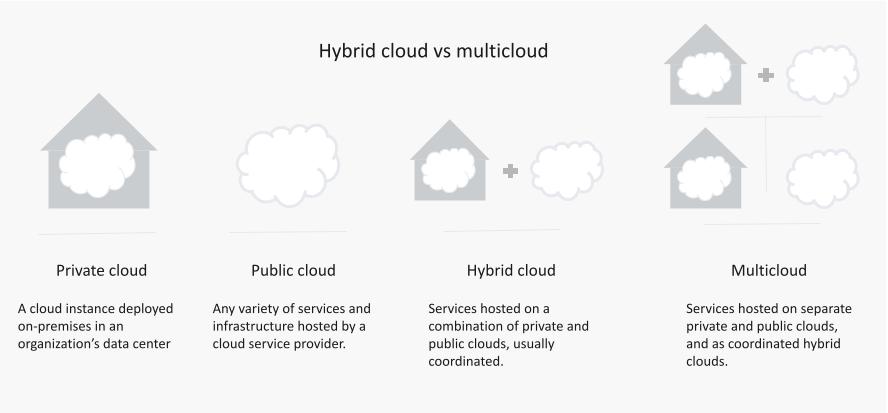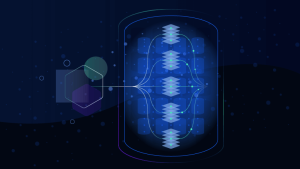More than 90% of enterprises now rely on a hybrid cloud infrastructure to deliver innovative digital services and capture new markets. That’s because cloud platforms offer flexibility and extensibility for an organization’s existing infrastructure.
To drive better outcomes using hybrid cloud architectures, it helps to understand their benefits—and how to orchestrate them seamlessly.
What is hybrid cloud architecture?
Hybrid cloud architecture is a computing environment that shares data and applications on a combination of public clouds and on-premises private clouds. Public cloud refers to on-demand infrastructure and services provided by a third party over the public internet. With public clouds, multiple organizations share resources. Private cloud, on the other hand, refers to dedicated computing for a single organization. Private clouds can be either privately owned or hosted by a third-party provider.
The key to hybrid cloud infrastructure is seamless orchestration between the private and public services. For example, workflows from both public and private cloud resources can support an application.
Hybrid cloud architecture vs. multicloud architecture
While hybrid clouds and multiclouds are related, there is a distinct difference between the two.
A multicloud architecture typically involves a mix of services from multiple public cloud vendors. A hybrid cloud, however, combines public infrastructure and services with on-premises resources or a private data center to create a flexible, interconnected IT environment.
Hybrid environments provide more options for storing and analyzing ever-growing volumes of big data and for deploying digital services. Organizations can keep sensitive information in-house with strict user controls and enhanced security. Teams can then host and access less critical resources using a public cloud.

Five hybrid cloud platforms to consider
Third-party hybrid platforms provide infrastructure and services that run on a customer’s in-house resources and the provider’s public cloud. They use the same hardware, APIs, tools, and management controls for both the public and private clouds. Accordingly, these platforms provide a unified, consistent DevOps and IT experience.
Five available hybrid cloud platforms from the top public cloud providers include the following:
- Azure Stack: Consumers can access different Azure cloud services from their own data center and build applications for Azure cloud. Teams can then deploy these applications on Microsoft cloud infrastructure or on-premises.
- Amazon Web Services (AWS) Outpost: This offering provides pre-configured hardware and software for customers to run native AWS computing, networking, and services on-premises in a cloud-native manner.
- AWS Elastic Container Service (ECS) Anywhere: Users can run, stop, and manage containers in a cluster on their own on-premises infrastructure.
- AWS Elastic Kubernetes Service (EKS) Anywhere: Helps teams build Kubernetes clusters on AWS without having to install Kubernetes on EC2 compute instances manually.
- Google Cloud Platform (GCP) Anthos: Users can run applications on-premises, in GCP, or with other major public cloud providers like AWS and Microsoft Azure.
Altogether, these platforms offer specialized capabilities that give organizations the flexibility to integrate powerful, extensible cloud services with their on-premises assets.
How do hybrid clouds work?
Hybrid clouds integrate two or more types of public and private clouds with an orchestration layer at the top. This orchestration layer uses software-based tools to automate IT tasks and manage resources—virtualized or other. Therefore, workloads can flow easily between the private and public infrastructure.
An orchestration tool can create a new virtual machine instance and determine the best location in the cloud for deploying that instance. Teams can then install orchestration tools locally, or platforms can deliver them as a managed service. After deployment, IT teams can also optimize the software and supporting hardware to ensure high performance.
Key capabilities of hybrid architecture
Hybrid cloud architecture is a single, managed IT architecture that uses a WAN or broadband connection to share applications and data across two or more public and private computing environments.
The key capabilities of hybrid architecture enable enterprises to do the following:
- Integrate legacy private clouds with public clouds
- Support virtual machines and containers
- Provide visibility for workloads running across environments
- Orchestrate processes and workloads between environments
- Optimize critical applications’ performance
- Scale and provision new resources
- Automate observability and monitoring
There are two types of hybrid architecture: homogeneous and heterogeneous. A homogeneous model consists of private and public offerings—on-site or off-site—from a single vendor. A heterogeneous model, on the other hand, includes components from multiple vendors.
Managing hybrid architecture and its complexity
Hybrid cloud architecture can contain thousands of services, run millions of lines of code, and have trillions of dependencies. Managing this dynamic IT complexity is challenging and a top concern of CIOs. Therefore, IT teams need an in-depth understanding of security, governance, and end-user requirements of all environments—both public and private.
Hybrid cloud management requires a combination of tooling and visibility into workloads running across all environments.
What are the benefits of a hybrid cloud?
Hybrid infrastructure also provides the flexibility and agility to run highly variable workloads—such as virtual machines, containers, applications, databases—over the public internet while keeping highly sensitive data physically secured and behind a firewall on a private cloud.
Hybrid capabilities extend beyond what a private data center—and in-house IT and DevOps teams—can provide. As a result, hybrid cloud flexibility enables organizations to easily achieve greater redundancy and resiliency against performance issues and service outages.
What are the challenges of hybrid cloud architecture?
There are a variety of potential challenges an organization should consider with a hybrid architecture.
One is security. Inadequate security can result in weak points and failure of critical services. There’s also the possibility of migration difficulties due to cloud sprawl from not understanding the full scope of cloud environments, not exceeding the planned budget, and problems with scheduling and execution due to integration complexity.
Additional hybrid cloud challenges include the following:
- Monitoring and observing the performance of microservices in real time
- Preventing outages that affect the customer experience and a business’s reputation
- Achieving adequate security of sensitive data and workloads between private clouds and public clouds
- Allocating costs for resource optimization
- Maintaining compliance with security regulations
- Understanding how workloads use private and public resources
- Governance of standardized processes
All these challenges have the potential to undermine the customer experience and an organization’s reputation.
Solving hybrid cloud complexity with full-stack observability
To address hybrid cloud complexity, organizations need to make sense of the data coming from their platforms and services. The solution starts with observability, enabling organizations to measure the system states based on their logs, metrics, and traces. While observability enables teams to monitor their dynamic hybrid environments, it needs a boost and a single source of truth.
Dynatrace addresses these complexities by providing full-stack visibility into your mission-critical applications and their infrastructure. Whether running in private, public, or hybrid environments, Dynatrace Smartscape technology automatically discovers and maps your applications and their dependencies. This real-time map provides context for everything across your various cloud platforms—both vertically (infrastructure) and horizontally (application architecture).
Davis, Dynatrace’s AI causation engine, automatically tracks the performance of all application components in real time — even containerized processes running microservices. This gives organizations deep insight into the observed data, with precise root-cause analysis of anomalies for proactive problem resolution.
To learn more about modernizing your hybrid cloud operations, join us for the on-demand power Power Demo: Google Cloud Observability for Ops, Apps and Biz Teams.





Looking for answers?
Start a new discussion or ask for help in our Q&A forum.
Go to forum